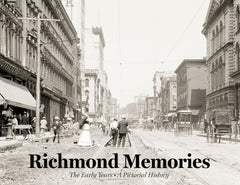The Jefferson Hotel, A Resurrection in Early Richmond
The long-winding story of the Jefferson Hotel in Richmond begins with one man, Lewis Ginter. Ginter moved to Richmond in 1842 at the age of 18. By the time he returned at age 50 he had served in the Confederate Army, and made and lost two fortunes: One in the import business that was undone by the Civil War, and one in the banking business that succumbed to a recession. He got involved in the tobacco business in Richmond, made his third fortune, and went on to become a civic leader and philanthropist. Stemming from his interest in art and architecture, Ginter left the tobacco business and started a new venture – land development.
He began construction on what would one day become a landmark in the city, the Jefferson Hotel, hoping to incorporate Renaissance and other forms of architecture he admired. The elegant building was designed by the Carrére and Hastings architecture firm, the same firm that designed the New York City Public Library, and the House and Senate buildings in Washington, D.C. The hotel cost several million dollars to complete, with the centerpiece of the project being a life-sized Carrera marble statue of Thomas Jefferson.
The Jefferson Hotel was opened for business in 1895, with thousands of people turning out to marvel at the architectural masterpiece, despite heavy rains the day of the opening. Sadly, Lewis Ginter was only able to enjoy his accomplishment for a short time; he died a mere two years after the hotel's completion. And the Jefferson's tenure in the city was nearly short-lived as well. A devastating fire in 1901 destroyed the majority of the hotel. One hundred guest rooms that weren't demolished by the fire remained open for the next several years while the hotel was slowly reconstructed.
Damage to the lobby of the Jefferson Hotel, 101 West Franklin Street, in Monroe Ward, after a fire in 1901. Courtesy The Valentine
Lobby and grand staircase in the Jefferson Hotel, circa 1908. Library of Congress, Prints & Photographs Division, Detroit Publishing Company Collection
Two prominent Richmond millionaires – Captain Joseph Willard, Lieutenant Governor of Virginia and principal owner of the Willard Hotel in Washington, D.C., and David Lowenberg, principal owner of the Monticello Hotel in Norfolk and Director-General of the forthcoming Jamestown Exposition – decided to finally make steps to restore the once-grand structure in time for the Exposition. In May 1907, their goal was accomplished; the enlarged hotel was reopened in time for the Jamestown Exposition. The restoration was designed by architect J. Kevan Peebles, who also designed the new wing of the Virginia State Capitol. Many interesting enhancements were made to the hotel, including marble pools being installed in which alligators were placed. Richmond residents even donated their pet alligators to stay in the hotel.
The Jefferson thrived for the next several decades, hosting a variety of political entities and celebrities over the years. It lodged recruits during World War II, and even survived a second fire in 1944. In 1980, the hotel saw what seemed to be the end of the long-enduring institution. The Jefferson was closed to all but an occasional movie-maker. Even this closure didn't last however. A local developer went to work in 1983 and organized a group of investors — and reconstruction began again. Stain-glassed ceilings were restored, oil paintings pulled from storage. Three years and $34 million later, the Jefferson opened its doors once more, and this time they stayed open.
In 2013, another round of reconstruction began on the Richmond landmark, and today the hotel is perhaps even more opulent than when its doors were first opened. If Mr. Ginter could see the lasting impact his project had on the city of Richmond he would surely be astonished, and very proud.
See these and hundreds more beautiful, historic photographs in the Times-Dispatch's new book, Richmond Memories: The Early Years.

$44.95
